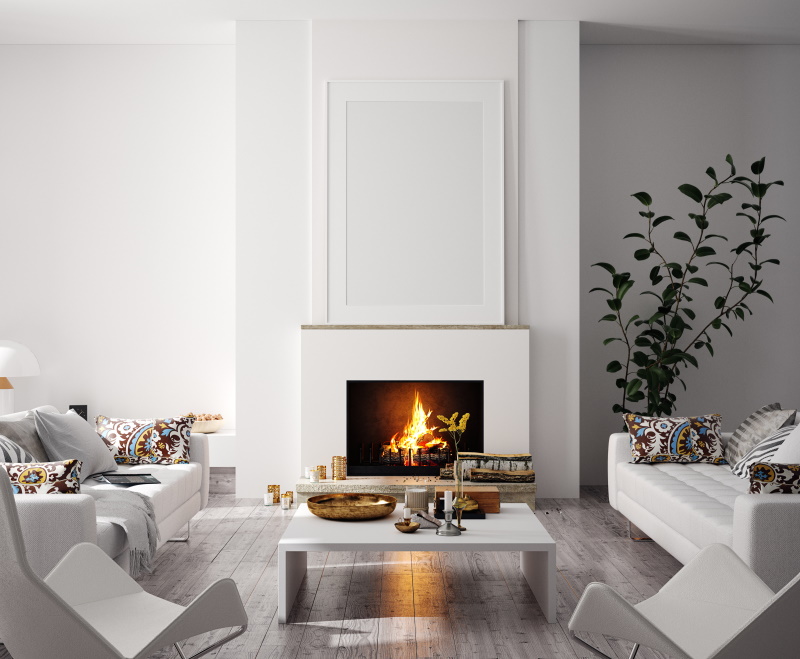If you, like me, are a certain age, smoke curling from chimneys and the earthy smell of woodsmoke from fireplaces and stoves represent the glories of winter.
Unfortunately, they also represent a threat to health and safety, which is why it may be time for all of us to think about replacing our woodburning fireplaces or stoves.
What’s Wrong with a Woodburning Fireplace?
Burning wood in a fireplace or stove releases toxic gasses, such as benzene and formaldehyde, into the environment. Smoke from woodburning also releases tiny particles (called particulate matter, or PM) into the air.
These particles can irritate the eyes and, when they are breathed in, can trigger asthma and other respiratory problems in susceptible people. Over time, they may also increase the risk for cardiovascular problems, like stroke and heart attack, and lung cancer in some people.
Making Every Day a Potential “Spare-the-Air” Day
Partly in response to the ongoing threat to air quality posed by the wildfires that seem to have become a regular feature of our summers and falls, the Bay Area Air Quality Management District (BAAQMD) in 2020 expanded its ban on wood burning during alert times (“Spare the Air” days) from winter-only to year-round.
When experts from BAAQMD predict that weather conditions will raise the risk of unhealthy levels of PM and air pollution, they call a Spare-the-Air alert to protect public health in the Bay Area. (You can sign up for alerts by text, email or phone here.)
During these alerts, it is illegal for home- or business-owners to use woodburning fireplaces or stoves. (There are exemptions during PG & E power shutoffs and for homes whose only source of heating is a woodburning stove or fireplace.) Violators can receive fines of $100 for a first offense, increasing for future violations.
Fireplace Replacement Options
If you have a woodburning fireplace or stove, you’re likely to find fewer and fewer days when you can legally enjoy it. Fortunately, there are options for replacement that can provide the beauty and warmth of a traditional fireplace without the pollution.
Gas Fireplaces
A gas fireplace uses natural gas – or, occasionally, propane – to fuel a fire.
If you have an existing fireplace, you can replace it with a new gas-fueled model, which will require some remodeling, or take a simpler, less expensive route and add a gas insert into the existing space.
An insert takes advantage of the existing structure, while a new gas fireplace offers almost limitless design options, including traditional in-wall or freestanding models.
While gas fireplaces don’t create particulate matter, they still produce gasses that need to be vented. Most often, a contractor will use your existing flue to run vent piping to remove gasses and bring fresh air into the firebox. Or you can choose to have your contractor create a new opening in the exterior wall or roof for venting if your fireplace doesn’t have a flue.
Whichever option you choose, you’ll have many choices for your fireplace’s look. These include:
- Ceramic log sets to replicate the look of a traditional woodburning fire
- Decorative glass chips for a more modern look
- Stone for a natural look
- Ceramic coal for a Victorian look
- Different frame style options, from traditional to modern, in a variety of colors and finishes
- Different firebox background finishes
Gas fireplaces offer different heat ratings, depending on the size of your space and how much heat you’d like to generate.
Electric Fireplaces
Like gas fireplaces, electric fireplaces can replace woodburning models and can consist of a self-contained unit or an insert. If you don’t have an existing gas line to the fireplace, an electric fireplace or insert may be less expensive than gas because it won’t require running a gas line.
While electric fireplaces replicate the look of a fire, unlike gas fireplaces, they don’t produce real flames and are less efficient at heating.
Financing Your Woodburning Fireplace Replacement
Through local air quality programs, the California Air Resources Board’s Woodsmoke Reduction Program offers financial incentives to some home- and business-owners in some locations to replace woodburning fireplaces and stoves.
Unfortunately, the BAQMD’s program is currently closed for applications, but you can sign up to be notified of program updates
The Northern Sonoma County Air Pollution Control District’s 3-2-1 Burn Clean! Program provides rebates to qualifying applicants who replace non-EPA-certified wood heating appliances (like stoves and fireplaces) with new EPA-certified gas or electric appliances.
Now’s the Time
With increasing restrictions on woodburning, now is the time to consider replacing your fireplace or stove with an energy-efficient, clean-burning model.
Your architect or contractor can work with you to select an option that provides you the most energy-efficient, cost-effective solution for enhancing the beauty and warmth of your home or business.


